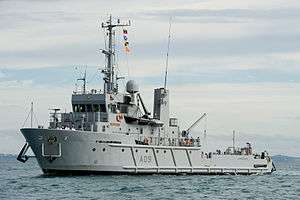HMNZS Manawanui (A09)
HMNZS Manawanui (A09) was commissioned in 1988 as a diving support vessel for the Royal New Zealand Navy. Originally she was built as a diving support vessel, the Star Perseus, for North Sea oil rig operations.
 HMNZS Manawanui in 2010 | |
| History | |
|---|---|
| Name: | HMNZS Manawanui (A09) |
| Builder: | Cochrane Shipbuilders Limited, Selby[1] |
| Commissioned: | 1988 |
| Decommissioned: | 23 February 2018 |
| Identification: |
|
| Status: | Decommissioned |
| General characteristics | |
| Displacement: | 911 tonnes standard |
| Length: | 43 m (141 ft) |
| Beam: | 9.5 m (31 ft) |
| Draught: | 3.2 m (10 ft) |
| Propulsion: |
Two 565 hp Caterpillar marine diesels with twin shafts. Bow thrusters Diesel with controllable-pitch propeller |
| Speed: | 11 knots (20 km/h) |
| Range: | 5,000 nmi (9,300 km; 5,800 mi) |
| Complement: | 24 officers and ratings |
| Armament: | 2x 12.7mm machine guns |
Manawanui is the third ship with this name to serve in the New Zealand Navy. Manawanui is a Māori word meaning "to be brave or steadfast".
Manawanui has a capability to hold station over a fixed position. She has a triple lock recompression chamber, a crane with 13 tonne lifting capacity, wet diving bell and a small engineering workshop. She also has limited deck cargo carrying capacity.
The divers of the New Zealand Navy who work onboard Manawanui are trained for deep diving with mixed gases, underwater demolition and unexploded ordnance disposal.
An ROV operated from the Manawanui returned photos of the wreck of the MV Princess Ashika, which sank near Ha'apai, Tonga on 5 August 2009.[2]
The vessel was decommissioned at Devonport Naval Base on February 23, 2018.[3][4]
In July 2018 the ship was sold to the Major Projects Group, an Australian demotions company, and has been renamed as the MV Ocean Recovery[5]. The ship will be used by the Major Projects Foundation[6] (which was founded by the company) as a research and education vessel, with a focus on investigating and preventing oil spills from sunken ships in the Pacific.[7][8]
The new owners, Paul and Wilma Adams, plan to base the ship at Carrington, part of the Port of Newcastle, New South Wales, Australia. They plan for the ship to be the diving base for work in Chuuk Lagoon (Truk) and more generally in the Federated States of Micronesia, where the US Navy conducted Operation Hailstone in 1944 and sank numerous warships of the Imperial Japanese Navy along with merchant ships. They plan for cathodic protection to be applied to the wrecks, to reduce the chance of further discharge of bunker oil into the lagoons.[9]
References
- New Zealand Maritime Index: Star Perseus
- Field, Michael (19 August 2009). "Fatal ship wreck photographed". Stuff.co.nz. Retrieved 19 August 2009.
- Rahmat, Rdizwan (22 February 2018). "New Zealand decommissions diver support ship". Jane's Information Group.
The Royal New Zealand Navy (RNZN) has decommissioned its diver support ship, HMNZS Manawanui. The vessel was officially retired in a decommissioning ceremony held at Devonport Naval Base on the morning of 23 February.
- "Navy ship to pay last visit to Whitianga". SunLive. 8 January 2018. Retrieved 8 January 2018.
- Pacific Ocean World War II shipwrecks prompt fears of environmental devastation from oil leaks Cameron Gooley, ABC News 2019-05-26
- Major Projects Foundation, accessed 2018-09-11
- "New post for decommissioned Navy ship HMNZS Manawanui". Waikato Times. 2 July 2018. Retrieved 27 August 2018.
- "Major Projects Foundation". Retrieved 27 August 2018.
- Conservation couple buys New Zealand Navy warship Tim Connell, ABC News Online, 2018-09-11